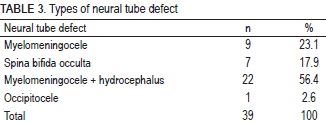Incidence and risk factors for neural tube defects in a Bosnian population
DOI:
https://doi.org/10.17532/jhsci.2021.1167Keywords:
neural tube defects, incidence, folic acid, risk factorsAbstract
Introduction: Neural tube defects (NTDs) are multifactorial congenital anomalies of the central nervous system that results from failed neural tube closure between the 3rd and 4th weeks of embryonic development. Numerous clinical and experimental studies indicate that supplementation with folic acid before and during early pregnancy reduces the development of these anomalies. The present study examined the incidence and risk factors for NTDs and evaluated the effects of folic acid supplementation.
Methods: This cross-sectional study included all children with NTDs who were hospitalized at the Pediatric Clinic, Clinical Centre University of Sarajevo during the period from January 01, 2008 to December 31, 2012. Data were collected retrospectively from the medical histories of hospitalized children. The study included children in pediatric clinics from four cantons (Sarajevo, Zenica–Doboj, Unsko–Sanski, and Central Bosnia) of the Federation of Bosnia and Herzegovina. The number of live births for the specified period in each of the four cantons was taken from a report by the Cantonal Ministry of Health.
Results: Among the 69,096 live births recorded during the study period, 39 children had verified NTDs, with an overall incidence of 0.56:1,000 (or 5.6:10,000) in all four cantons. The most common NTDs were myelomeningocele with hydrocephalus (22/39, 56.4%), followed by isolated myelomeningocele (9/39, 23.1%), spina bifida occulta (7/39, 17.9%), and occipitocele (1/39, 2.6%). A total of 33.3% (13/39) of mothers took folic acid, but only one began supplementation prior to pregnancy, while 67.7% (26/39) of mothers did not take folic acid during pregnancy. NTDs were found more frequently in primiparas (53.8%), women with low education (basic school, 64.1%), and unemployed women (82.1%).
Conclusion: It is important to make national recommendations for folic acid supplementation for women of reproductive age, but also change the public health policy that includes mandatory fortification of basic foods as this is the best measure for primary prevention of NTDs in the whole population regardless of employment and education status. Additional comprehensive studies are required to assess the incidence and risk factors throughout Bosnia and Herzegovina.
Downloads

Downloads
Published
License
Copyright (c) 2021 Elmedina Mrkulić, Emina Vukas, Hajrija Maksić, Meliha Sakić, Jasmina Mahmutović, Selma Dizdar, Alma Mizdrak, Verica Mišanović

This work is licensed under a Creative Commons Attribution 4.0 International License.










